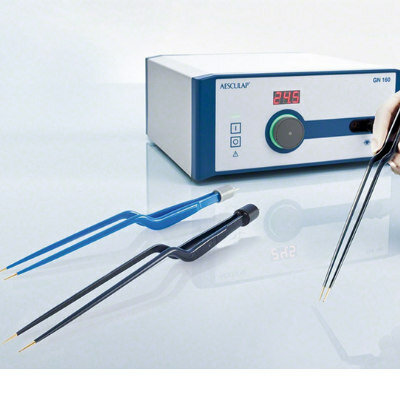Handheld Smart Tool Aids Knee Replacement Surgery
|
By HospiMedica International staff writers Posted on 23 Nov 2021 |

Image: The next-generation Lantern navigation system (Photo courtesy of OrthAlign)
An innovative digital assistant with inertial navigation technology provides accurate, individualized alignment for both total and unicompartmental knee arthroplasty.
The next-generatrion OrthAlign (Aliso Viejo, CA, USA) Lantern is a navigation assistance system the size of a cellphone that uses micro-electromechanical sensors (MEMS) to register patient anatomy and guide precise orthopedic implant placement. The system’s internal gyroscopes and accelerometers require no pre-operative imaging, and the cost-effective, portable, and open-implant design make it an ideal technology for both outpatient and inpatient settings.
The kinematic sensor technology is optimized for ambulatory surgery centers (ASCs) with only one instrument tray, one navigation unit for all applications, and no storage requirements or service plans. Lantern also provides enhanced data collection capabilities, fast network connectivity, and intraoperative assessment tools such as soft tissue balancing. Studies have shown the system can provide tibial coronal alignment within 2° of neutral, and femoral sagittal alignment within 3° of neutral.
“Lantern is our next-generation flagship product. It's the culmination of years of effort devoted to developing a technology that offers the accuracy, simplicity, and efficiency needed in today's transitioning market,” said Eric Timko, Chairman and CEO of OrthAlign. “With Lantern, we are perfectly positioned to meet the operational needs of the hospital and ASC, while continuing to provide the strong clinical outcomes that surgeons expect.”
“The system is intuitive, and its open platform makes the technology accessible to every orthopedic surgeon. It is one of the most simple and efficient systems you can bring into a hospital or ASC,” said Michael Ast, MD, of the Hospital for Special Surgery (HSS; New York, NY, USA), who performed the first cases in the United States. “The data is highly accurate, which gives me confidence that the foundations of my surgery are on target.”
Proper axial alignment is of paramount importance for the longevity of any knee implant, and even minor deviations can lead to early loosening, increased wear, and poor function. Misalignment of any of the components, in any anatomical plane, can result in major complications. For example, inaccurate rotation of either the femoral or tibial component will critically affect patellar tracking and can lead to patellar subluxation or dislocation.
Related Links:
OrthAlign
The next-generatrion OrthAlign (Aliso Viejo, CA, USA) Lantern is a navigation assistance system the size of a cellphone that uses micro-electromechanical sensors (MEMS) to register patient anatomy and guide precise orthopedic implant placement. The system’s internal gyroscopes and accelerometers require no pre-operative imaging, and the cost-effective, portable, and open-implant design make it an ideal technology for both outpatient and inpatient settings.
The kinematic sensor technology is optimized for ambulatory surgery centers (ASCs) with only one instrument tray, one navigation unit for all applications, and no storage requirements or service plans. Lantern also provides enhanced data collection capabilities, fast network connectivity, and intraoperative assessment tools such as soft tissue balancing. Studies have shown the system can provide tibial coronal alignment within 2° of neutral, and femoral sagittal alignment within 3° of neutral.
“Lantern is our next-generation flagship product. It's the culmination of years of effort devoted to developing a technology that offers the accuracy, simplicity, and efficiency needed in today's transitioning market,” said Eric Timko, Chairman and CEO of OrthAlign. “With Lantern, we are perfectly positioned to meet the operational needs of the hospital and ASC, while continuing to provide the strong clinical outcomes that surgeons expect.”
“The system is intuitive, and its open platform makes the technology accessible to every orthopedic surgeon. It is one of the most simple and efficient systems you can bring into a hospital or ASC,” said Michael Ast, MD, of the Hospital for Special Surgery (HSS; New York, NY, USA), who performed the first cases in the United States. “The data is highly accurate, which gives me confidence that the foundations of my surgery are on target.”
Proper axial alignment is of paramount importance for the longevity of any knee implant, and even minor deviations can lead to early loosening, increased wear, and poor function. Misalignment of any of the components, in any anatomical plane, can result in major complications. For example, inaccurate rotation of either the femoral or tibial component will critically affect patellar tracking and can lead to patellar subluxation or dislocation.
Related Links:
OrthAlign
Latest Surgical Techniques News
- Robotic Assistant Delivers Ultra-Precision Injections with Rapid Setup Times
- Minimally Invasive Endoscopic Surgery Improves Severe Stroke Outcomes
- Novel Glue Prevents Complications After Breast Cancer Surgery
- Breakthrough Brain Implant Enables Safer and More Precise Drug Delivery
- Bioadhesive Sponge Stops Uncontrolled Internal Bleeding During Surgery
- Revolutionary Nano Bone Material to Accelerate Surgery and Healing
- Superior Orthopedic Implants Combat Infections and Quicken Healing After Surgery
- Laser-Based Technique Eliminates Pancreatic Tumors While Protecting Healthy Tissue
- Surgical Treatment of Severe Carotid Artery Stenosis Benefits Blood-Brain Barrier
- Revolutionary Reusable Duodenoscope Introduces 68-Minute Sterilization
- World's First Transcatheter Smart Implant Monitors and Treats Congestion in Heart Failure
- Hybrid Endoscope Marks Breakthrough in Surgical Visualization
- Robot-Assisted Bronchoscope Diagnoses Tiniest and Hardest to Reach Lung Tumors
- Diamond-Titanium Device Paves Way for Smart Implants that Warn of Disease Progression
- 3D Printable Bio-Active Glass Could Serve as Bone Replacement Material
- Spider-Inspired Magnetic Soft Robots to Perform Minimally Invasive GI Tract Procedures
Channels
Critical Care
view channel
CPR Guidelines Updated for Pediatric and Neonatal Emergency Care and Resuscitation
Cardiac arrest in infants and children remains a leading cause of pediatric emergencies, with more than 7,000 out-of-hospital and 20,000 in-hospital cardiac arrests occurring annually in the United States.... Read more
Ingestible Capsule Monitors Intestinal Inflammation
Acute mesenteric ischemia—a life-threatening condition caused by blocked blood flow to the intestines—remains difficult to diagnose early because its symptoms often mimic common digestive problems.... Read more
Wireless Implantable Sensor Enables Continuous Endoleak Monitoring
Endovascular aneurysm repair (EVAR) is a life-saving, minimally invasive treatment for abdominal aortic aneurysms—balloon-like bulges in the aorta that can rupture with fatal consequences.... Read more
Wearable Patch for Early Skin Cancer Detection to Reduce Unnecessary Biopsies
Skin cancer remains one of the most dangerous and common cancers worldwide, with early detection crucial for improving survival rates. Traditional diagnostic methods—visual inspections, imaging, and biopsies—can... Read morePatient Care
view channel
Revolutionary Automatic IV-Line Flushing Device to Enhance Infusion Care
More than 80% of in-hospital patients receive intravenous (IV) therapy. Every dose of IV medicine delivered in a small volume (<250 mL) infusion bag should be followed by subsequent flushing to ensure... Read more
VR Training Tool Combats Contamination of Portable Medical Equipment
Healthcare-associated infections (HAIs) impact one in every 31 patients, cause nearly 100,000 deaths each year, and cost USD 28.4 billion in direct medical expenses. Notably, up to 75% of these infections... Read more
Portable Biosensor Platform to Reduce Hospital-Acquired Infections
Approximately 4 million patients in the European Union acquire healthcare-associated infections (HAIs) or nosocomial infections each year, with around 37,000 deaths directly resulting from these infections,... Read moreFirst-Of-Its-Kind Portable Germicidal Light Technology Disinfects High-Touch Clinical Surfaces in Seconds
Reducing healthcare-acquired infections (HAIs) remains a pressing issue within global healthcare systems. In the United States alone, 1.7 million patients contract HAIs annually, leading to approximately... Read moreHealth IT
view channel
Printable Molecule-Selective Nanoparticles Enable Mass Production of Wearable Biosensors
The future of medicine is likely to focus on the personalization of healthcare—understanding exactly what an individual requires and delivering the appropriate combination of nutrients, metabolites, and... Read moreBusiness
view channel
Philips and Masimo Partner to Advance Patient Monitoring Measurement Technologies
Royal Philips (Amsterdam, Netherlands) and Masimo (Irvine, California, USA) have renewed their multi-year strategic collaboration, combining Philips’ expertise in patient monitoring with Masimo’s noninvasive... Read more
B. Braun Acquires Digital Microsurgery Company True Digital Surgery
The high-end microsurgery market in neurosurgery, spine, and ENT is undergoing a significant transformation. Traditional analog microscopes are giving way to digital exoscopes, which provide improved visualization,... Read more
CMEF 2025 to Promote Holistic and High-Quality Development of Medical and Health Industry
The 92nd China International Medical Equipment Fair (CMEF 2025) Autumn Exhibition is scheduled to be held from September 26 to 29 at the China Import and Export Fair Complex (Canton Fair Complex) in Guangzhou.... Read more












